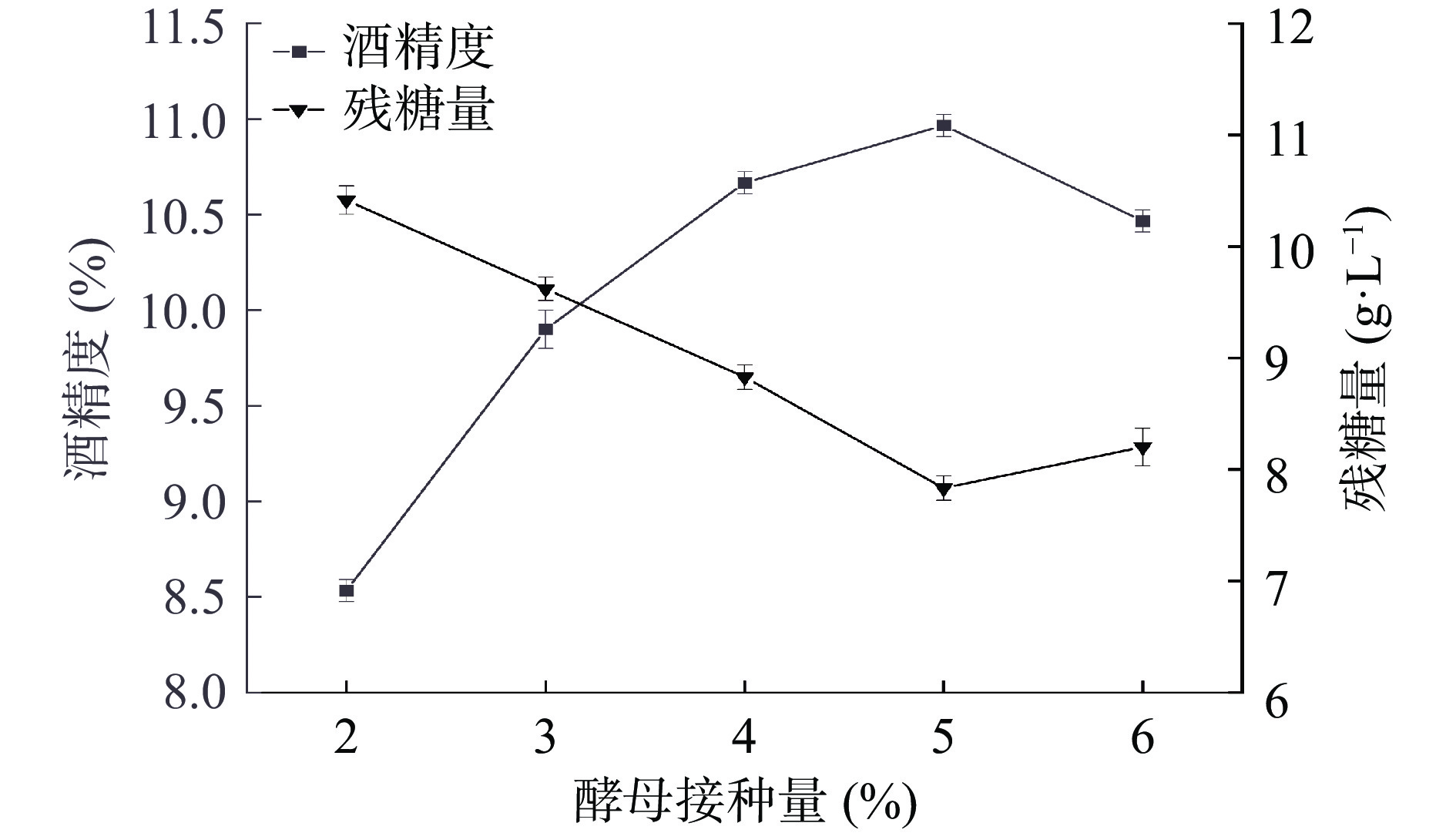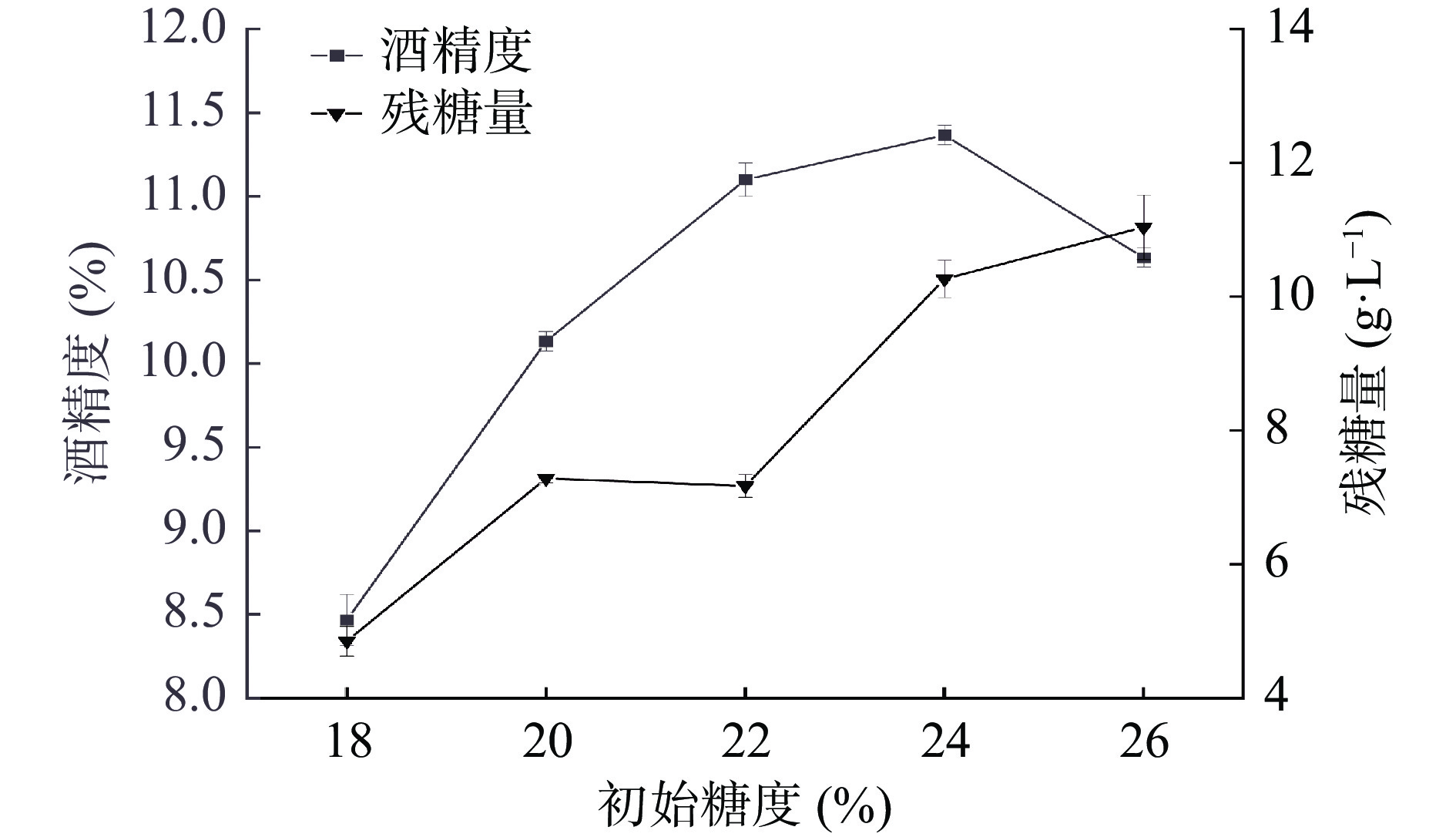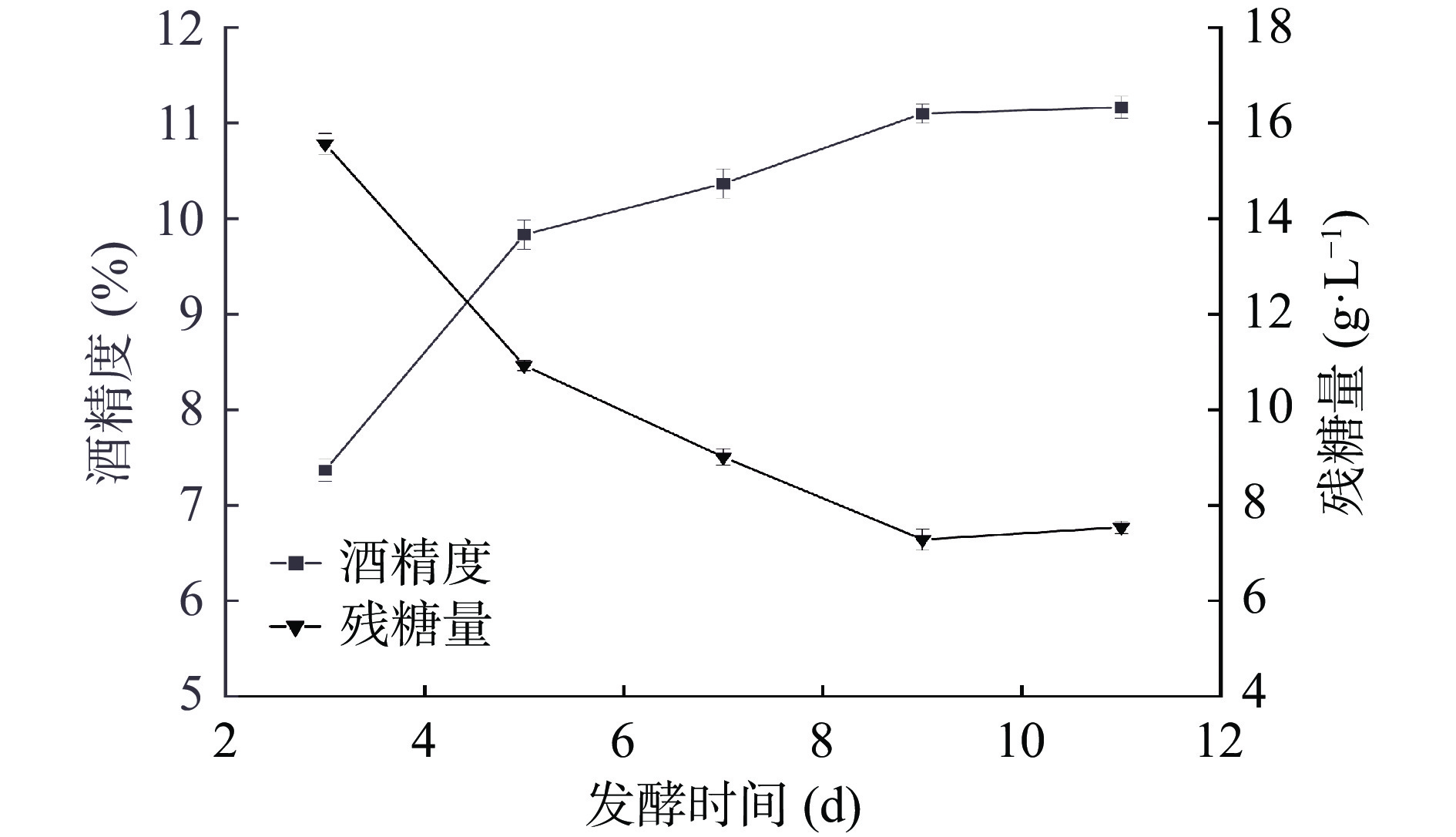Process Optimization and Quality Analysis of Lycopus lucidus Fermented Wine
-
摘要: 目的:以新鲜的地参为原料,研究地参发酵酒的最佳工艺。方法:采用单因素实验和Box-Behnken响应面优化地参发酵酒的工艺条件,以酒精度及感官评分为响应值,考察发酵温度、酵母接种量和初始糖度对发酵酒的影响,采用UPLC法对地参发酵酒的酚酸类物质进行了分析。结果:地参发酵酒最佳工艺条件为:酵母接种量为5.1%,初始糖度为22.8%,发酵温度为26 ℃,发酵时间为9 d。在此条件地参发酵酒酒精度达到11.23%vol,感官评分为85.50分,多糖、总酚、总酸和总黄酮含量分别为6.54 g/L、384.31 mg/L、20.67 g/L和204.59 mg/L。地参发酵酒的ABTS+、DPPH和对羟基自由基的清除率分别为90.53%、81.51%和55.86%,说明其具有一定的抗氧化活性;地参发酵酒含有没食子酸、丹参素、原儿茶酸、对羟基苯甲酸和咖啡酸5种酚酸类物质,其中没食子酸含量最高(11.20 mg/L)。结论:优化工艺后的地参发酵酒色泽呈橘黄色,澄清透明,酒体醇厚丰满,不仅具有独特的地参酒风味,同时较好的保留了地参发酵酒多酚等活性成分。Abstract: Objective: In this research, to study the best technology of fermented wine with fresh Lycopus lucidus as raw material. Methods: According to the results of single factor test, Box-Behnken response surface was used to optimize the technological conditions of L. lucidus fermented wine, and the effects of fermentation temperature, yeast inoculation amount and initial sugar content on fermented wine were investigated with alcohol content and sensory score as response values. Meanwhile, the phenolic acids in L. lucidus fermented wine were analyzed by UPLC. Results: In this study, the optimum technological conditions of L. lucidus fermentation wine were found to be yeast inoculation of 5.1%, initial sugar content of 22.8%, fermentation temperature of 26 ℃ and fermentation time of 9 days. The alcohol content of the fermented wine reached 11.23%vol, the sensory score was 85.50, and the contents of polysaccharide, total phenol, total acid and total flavone were 6.54 g/L, 384.31 mg/L, 20.67 g/L and 204.59 mg/L. The scavenging rates of ABTS+, DPPH and hydroxyl free radicals of L. lucidus fermented wine were 90.53%, 81.51% and 55.86%, indicating that it had certain antioxidant activity. L. lucidus fermented wine contains five phenolic acids including gallic acid, tanshinsu, protocatechuic acid, p-hydroxybenzoic acid and caffeic acid, of which gallic acid content was the highest (11.20 mg/L). Conclusion: The optimized technology of L. lucidus fermented wine was orange, clear and transparent, and the wine was mellow and full. It not only had a unique flavor of L. lucidus fermented wine, but also retained the active components such as polyphenols.
-
Keywords:
- Lycopus lucidus /
- fermented wine /
- process optimization /
- phenolic acids /
- quality analysis /
- antioxidant activity
-
地参(Lycopus lucidus)又名虫草参,银条菜,地蚕子,是唇形科地笋属多年生草本植物,其形状、营养与人参相似[1]。在《中华本草》资料中记载了地参可作为蔬菜食用,其晒干之后还可以入药,功能与冬虫夏草相当[2]。药理研究表明[3],地参中含有大量的多酚类和多糖类,具有降血糖、抗氧化、抗肿瘤等疗效作用。地参可作为蔬菜食用,其保健功能丰富,享有“蔬菜珍品”、“山中之王”等美誉[4]。
目前国内外对地参药理研究主要集中在地参多糖、多酚等成分的提取研究[5-7],现有的对地参的工艺研究包括地参酸奶[8]、地参酸辣发酵羊蹄[9]、地参枸杞汁[10]等休闲食品,没有关于用鲜地参进行发酵酒的研究报道。针对目前市场上的地参加工成品,加工方法略微粗放,工业化程度较低,其产品质量稳定难以控制[11]。地参作为药食兼用的植物,营养成分丰富,保健功能明显,有着很大的开发利用价值,且地参含有大量的糖类物质,可作为酿造保健型发酵酒的良好原材料。因此,有必要对地参开展深加工技术,开发利用地参中的其它活性成分,提升地参产品附加值。
本研究以新鲜地参为原料,通过单因素和响应面试验来确定地参发酵酒的发酵工艺条件,并对其体外抗氧化活性和酚酸类物质进行分析,旨在酿造出一款口感佳、营养丰富、具有地参典型风味的地参发酵酒,为地参的深加工提供理论依据。
1. 材料与方法
1.1 材料与仪器
鲜地参 重庆市万州区恒合乡石桶寨村种植地;酿酒酵母(Saccharomyces cerevisiae)DY9 自筛选地参发酵酒专用酵母菌;酵母浸出粉葡萄糖培养基(YPD液体培养基) 青岛高科技工业园海博生物技术有限公司;DPPH(2,2-联苯基-1-苦基肼基)、ABTS 西亚化学科技(山东)有限公司;没食子酸、芦丁 北京索莱宝科技有限公司;丹参素、对羟基苯甲酸、咖啡酸 成都曼思特生物科技有限公司;原儿茶酸 上海源叶生物科技有限公司;白砂糖 重庆野山珍商贸有限公司;甲醇(色谱纯) 德国默克公司;氢氧化钠、过硫酸钾、苯酚、硫酸等试剂 成都市科隆化工试剂厂,均为分析纯。
ACQUITY UPLC H-Class 超高效液相色谱仪 美国Waters公司;L18-Y915S型高速破壁调理机 九阳股份有限公司;PHS-3C型精密酸度计 杭州齐威仪器有限公司;酒精计 衡水创纪仪器表有限公司;FA1004型电子天平 上海舜宇恒平科学仪器有限公司;YRE-2000A型旋转蒸发仪 巩义市予华仪器有限公司;V-1200型紫外可见分光光度计 上海美谱达仪器有限公司;HSY-26型水浴锅、HDPN-Ⅱ-256型电热恒温培养箱 上海跃进医疗器械有限公司。
1.2 实验方法
1.2.1 地参发酵酒的工艺流程和操作要点
地参发酵酒的工艺流程如图1所示,操作要点如下:
地参汁制备:挑选新鲜无病害的地参清洗,备用。新鲜地参按一定的料液比(1:2)榨汁,按地参汁总质量的0.1%添加果胶酶,40 ℃酶解2 h;添加焦亚硫酸钾(80 mg/L),用白砂糖调节糖度,用柠檬酸将pH调至酵母菌最适生长值4~4.5;
酵母活化:取自筛的酿酒酵母DY9,划线于YPD固体培养基上,28 ℃培养48 h,挑取单个菌落接种于YPD液体培养基中,于28 ℃的摇床振荡培养20 h,将1 mL菌液接入100 mL YPD液体培养基中,连续扩增。
发酵:将调整好成分的地参汁放入发酵瓶(500 mL)中,在水浴70 ℃下杀菌30 min,冷却至室温,接入活化好的酵母,使用硅胶塞单向阀盖好发酵瓶,按试验设计的发酵时间、温度进行发酵,发酵结束后,用4层纱布过滤去除发酵残渣,得到的酒液放置14~18 ℃下低温陈酿2个月。
灭菌:采用巴氏灭菌法,将澄清处理后的地参发酵酒置70 ℃热水中20 min。
1.2.2 单因素实验设计
1.2.2.1 酵母接种量
设不同酵母接种量为2.0%、3.0%、4.0%、5.0%、6.0%,发酵温度24 ℃,初始糖度22%,发酵时间9 d,发酵结束后测定发酵酒的酒精度和残糖含量,研究不同酵母接种量对发酵酒品质(酒精度和残糖量)的影响。
1.2.2.2 发酵温度
设不同发酵温度为19、22、25、28、31 ℃,酵母接种量5%,初始糖度22%,发酵时间9 d,发酵结束后测定发酵酒的酒精度和残糖含量,研究不同发酵温度对发酵酒的品质影响。
1.2.2.3 初始糖度
设不同初始糖度为18%、20%、22%、24%、26%,酵母接种量5%,发酵温度24 ℃,发酵时间9 d,发酵结束后测定发酵酒的酒精度和残糖含量,研究不同初始糖度对发酵酒的品质影响。
1.2.2.4 发酵时间
设不同发酵时间为3、5、7、9、11 d,发酵温度24 ℃,初始糖度22%,酵母接种量5%,发酵结束后测定发酵酒的酒精度和残糖含量,研究不同发酵时间对发酵酒的品质影响。
1.2.3 响应面试验设计
在单因素实验的基础上,选择发酵温度(A)、酵母接种量(B)和初始糖度(C)三个影响因素,以感官评分、酒精度为响应值,采用Box-Behnken中心组合设计原理设计响应面试验[12-14],试验因素及水平编码见表1。
表 1 响应面试验因素水平表Table 1. Factors and levels for response surface experiment水平 因素 A发酵温度(℃) B酵母接种量(%) C初始糖度(%) −1 22 4 20 0 25 5 22 1 28 6 24 1.2.4 理化指标测定
按照GB/T 15038-2006《葡萄酒、果酒通用分析方法》中酒精计法进行酒精度的测定[15];总酸(以柠檬酸计):按照GB/T 12456-2021《食品中总酸的测定》中的pH计电位滴定法测定[16];残糖量的测定:采用3,5-二硝基水杨酸(DNS)比色法[17];总酚含量的测定:采用Folin-Ciocaltue法[18],以没食子酸为对照品,标准曲线为y=1.5482x+0.4538,R2=0.9995;黄酮含量测定采用NaNO2-Al(NO3)3方法[19],以芦丁为标准品,标准曲线为y=10.541x−0.027,R2=0.9998;多糖含量的测定采用硫酸-苯酚比色法[20],以葡萄糖为标准品,标准曲线为y=0.121x−0.0005,R2=0.9989。
1.2.5 感官评价
随机选择10名食品专业人员,从地参发酵酒的外观、滋味、香气、典型性4个指标进行评定,满分100分,感官评分结果取平均值。感官品评表见表2。
表 2 地参发酵酒感官评分标准Table 2. Standard of sensory evaluation for Lycopus lucidus fermented wine指标 评分标准 分值 外观(10分) 澄清透明,橘黄色有光泽,无絮状物
澄清透明,橘黄色光泽较柔,无絮状物
淡橘黄色,无光泽,浑浊9~10
5~8
0~4香气(30分) 有愉悦的地参香和酒香,无异味
地参香气味较浓,酒香一般,无异味
香气味混杂,有异味21~30
11~20
0~10滋味(40分) 酒体醇厚丰满或酒体爽口,风味协调
酸甜适当,酒体较柔和,口感较佳
酒体味道寡淡,口感较差31~40
21~30
0~20典型性(20分) 具独特的地参酒风味,酒香纯正优雅
地参香味不明显,酒香不优雅
无风味,缺乏典型性16~20
11~15
0~101.2.6 地参发酵酒抗氧化能力的测定
将酒样稀释10倍后,吸取1.0 mL样品于刻度试管中进行实验。DPPH自由基清除能力的测定:参考苏龙等[21]的测定方法稍作修改;ABTS+自由基清除能力的测定:参考Miriam等[22]的方法稍作修改;对羟自由基清除能力的测定:参考万景瑞等[23]的方法稍作修改;以上方法均以0.1 mg/mL的VC为阳性对照,计算公式为:
式中:A1为样品溶液吸光度;A2为本底吸光度;A0为空白溶液吸光度。
1.2.7 地参发酵酒酚酸类物质的测定
对照品溶液的制备:分别精密称取没食子酸、对羟基苯甲酸、咖啡酸、丹参素、原儿茶酸对照品适量,置于10 mL棕色容量瓶中,加80%甲醇溶解并定容至刻度线,得到浓度分别为0.709、1.2、1.426、0.204、0.448 mg/mL的对照品贮备液,于4 ℃冰箱保存,备用。
样品溶液的制备:参考朱霞建等[24]的方法并稍作修改。取地参发酵酒20 mL,用1 mol/L NaOH 调节pH为7左右,加入20 mL乙酸乙酯反复萃取3次,合并上清液,40 ℃ 旋转蒸发浓缩至干,用甲醇复溶并定容至2 mL,过0.22 μm有机滤膜上机测定。
色谱条件:参考唐柯等[25]的方法并稍作修改。以ACQUITY UPLC BEH C18(2.1 mm×150 mm,1.7 μm)为色谱柱;以0.1%磷酸为流动相A,甲醇为流动相B,梯度洗脱(0~4 min,10%~20% B;4~9 min,20%~40% B;9~10 min,40%~10% B;10~12 min,10% B);流速0.3 mL/min;柱温35 ℃;检测波长280 nm;进样体积1 μL。
1.3 数据处理
全部试验重复3次,数据处理及分析采用Excel 2010。响应面试验设计及结果分析采用Design-Expert 8.0.6.1软件,用Origin 2021绘图软件绘制试验结果图。
2. 结果与分析
2.1 单因素实验结果
2.1.1 酵母接种量对地参发酵酒的影响
不同酵母接种量对地参发酵酒精度及残糖量的影响结果见图2。由图2可知,随着酵母接种量的增加,酒精度出现先升高后降低的现象,当酵母接种量为5%时,酒精度出现了最大值,残糖含量最低。当酵母量超过5%时,酒精度降低的同时残糖量也略微增高,可能是因为酵母接种量过多,酵母生长代谢旺盛,会消耗发酵液中大量营养物质,影响了微生物的发酵导致酒精产量低[26]。当酵母接种量少时,发酵的速度慢,容易产生杂菌,从而影响发酵酒的口感[27]。经发酵酒精度及残糖含量综合考虑,选择酵母接种量为4%、5%、6%进行响应面试验。
2.1.2 发酵温度对地参发酵酒的影响
不同发酵温度对地参发酵酒精度及残糖量的影响结果见图3。由图3可知,在19~25 ℃温度范围内时,随着温度的增加酒精度也升高。温度为25 ℃时酒精度达到了最大值,残糖含量最低。当温度在超过25 ℃时,发酵生成的酒精度呈下降趋势,残糖含量逐渐增多,发酵温度过高,酵母菌繁殖速度加快,容易使菌体提前衰老,不利于糖转化为酒精,温度高发酵物中风味物质易挥发,影响发酵酒的口感。经发酵酒精度及残糖含量综合考虑,选择发酵温度为22、25、28 ℃进行响应面试验。
2.1.3 初始糖度对地参发酵酒的影响
不同初始糖度对地参发酵酒精度及残糖量的影响结果见图4。在发酵的过程中酵母菌利用糖进行生长繁殖,并将糖转化为酒精。由图4可知,随着初始糖度的增加,酒精度呈现出先升高后降低的情况,残糖含量在逐渐的增加。初始糖度太低,生成的酒精度低,酒的口感寡淡。初始糖度含量过多会增加发酵液的渗透压,酵母菌代谢活动会受到抑制,多余的糖未能转化为酒精导致酒精度降低,发酵酒中的剩余糖量过多,从而影响了发酵酒的口感[28]。当初始糖度为22%时,发酵酒的酒精度、残糖含量适中。因此,经发酵酒精度及残糖含量综合考虑,选择初始糖度为20%、22%、24%进行响应面试验。
2.1.4 发酵时间对地参发酵酒的影响
发酵时间过短或过长都会对酒的品质造成影响。由图5可知,当发酵时间为3 d时,酒精度最低,残糖量最高;在发酵时间3~9 d的范围内时,酒精度随着时间的延长而增加,这个阶段残糖量下降迅速。发酵时间为9 d时,酒精度的增长最快,酒精度达到了最大值,在9~11 d时酒精度基本不再生长,残糖量下降缓慢。发酵后期,发酵液中剩余的营养成分较少,酵母的生长受到了抑制,部分酵母衰老[29]。经发酵酒精度及残糖量综合考虑,加上时间的成本选择时间9 d为最佳发酵时间。
2.2 响应面试验
2.2.1 响应面试验结果
根据单因素实验结果,以发酵温度(A)、酵母接种量(B)和初始糖度(C)为自变量,分别以酒精度(Y1)和感官评分(Y2)为因变量进行Box-Benhken响应面优化设计试验,试验结果见表3。
表 3 地参发酵酒工艺优化响应面试验设计及结果Table 3. Experimental design and results of optimized response surface of Lycopus lucidus fermentation wine process实验号 A B C 酒精度(%vol) 感官评分(分) 1 0 0 0 10.93±0.06 84.70±1.89 2 0 1 −1 9.30±0.10 73.80±2.53 3 0 −1 −1 9.73±0.12 75.50±1.65 4 0 0 0 11.17±0.15 85.10±1.73 5 −1 1 0 9.97±0.12 76.80±2.62 6 −1 −1 0 10.07±0.12 80.10±2.77 7 0 0 0 10.93±0.15 84.00±2.11 8 −1 0 −1 9.57±0.06 75.00±2.05 9 1 −1 0 9.93±0.15 80.20±1.93 10 1 0 −1 9.77±0.06 75.10±2.77 11 0 0 0 11.13±0.12 84.10±1.73 12 1 1 0 10.70±0.10 83.00±2.26 13 0 1 1 10.23±0.06 81.40±1.72 14 1 0 1 10.87±0.15 82.50±2.27 15 −1 0 1 10.37±0.15 81.30±2.18 16 0 −1 1 10.33±0.12 80.90±1.28 17 0 0 0 11.20±0.10 84.80±2.10 利用Design Expert 8.0.6.1软件对表3数据进行二次回归方程拟合,分别得到酒精度(Y1)和感官评分(Y2)对发酵温度(A)、酵母接种量(B)和初始糖度(C)的二次多项回归方程:
Y1=11.07+0.16A+0.017B+0.43C+0.22AB+0.075AC+0.083BC−0.33A2−0.58B2−0.60C2
Y2=84.54+0.95A−0.21B+3.34C+1.52AB+0.28AC+0.55BC−1.97A2−2.54B2−4.09C2
方差分析结果显示,所得回归模型极显著(P<0.01),失拟项不显著(P>0.05),证明所得模型能充分拟合试验数据,能够较好的预测试验值,详见表4。由P值结果得出3种因素对地参发酵酒酒精度影响的强弱顺序依次为:初始糖度>发酵温度>酵母接种量。一次项C对酒精度的影响极显著(P<0.01),A、B对酒精度影响不显著;交互项AB、AC、BC对酒精度影响均不显著;二次项A2对酒精度影响显著(P<0.05),B2、C2对酒精度影响极显著(P<0.01);3种因素对地参发酵酒感官评分影响的强弱顺序依次为:初始糖度>发酵温度>酵母接种量。一次项C对感官评分的影响极显著(P<0.01),A对感官评分的影响显著(P<0.05),B对酒精度影响不显著;交互项AB对感官评分的影响极显著(P<0.01),AC、BC对感官评分影响均不显著;二次项A2、B2、C2对感官评分影响极显著(P<0.01)。
表 4 响应面试验方差分析Table 4. Variance analysis of response surface methodology来源 自由度 酒精度 感官评分 平方和 均方 F值 P值 平方和 均方 F值 P值 模型 9 5.64 0.63 16.36 0.0007** 233.46 25.94 43.86 < 0.0001** A 1 0.21 0.21 5.43 0.0526 7.22 7.22 12.21 0.0101* B 1 0.00245 0.00245 0.064 0.8077 0.36 0.36 0.61 0.4601 C 1 1.47 1.47 38.37 0.0004** 89.11 89.11 150.69 < 0.0001** AB 1 0.19 0.19 4.94 0.0617 9.30 9.3 15.73 0.0054** AC 1 0.022 0.022 0.59 0.4686 0.30 0.3 0.51 0.4976 BC 1 0.027 0.027 0.71 0.4272 1.21 1.21 2.05 0.1957 A2 1 0.45 0.45 11.85 0.0108* 16.34 16.34 27.63 0.0012** B2 1 1.4 1.4 36.45 0.0005** 27.27 27.27 46.12 0.0003** C2 1 1.51 1.51 39.35 0.0004** 70.61 70.61 119.4 < 0.0001** 残差 7 0.27 0.038 4.14 0.59 失拟项 3 0.2 0.066 3.8 0.1149 3.25 1.08 4.85 0.0805 纯误差 4 0.07 0.017 0.89 0.22 总离差 16 5.91 237.60 注:*表示在P<0.05 水平上显著,**表示在P<0.01 水平上极显著。 2.2.2 响应面结果分析
响应面是响应值受各影响因子影响程度的三维曲面图,能很好地反映不同影响因子间的相互作用强弱,且响应面图曲面坡度越陡峭、等高线越密集成椭圆形表示两因素交互影响越大[30]。
利用Design Expert 8.0.6.1软件对影响地参发酵酒酒精度和感官评分的3个因素进行交互分析,交互作用的大小由响应面的的陡峭程度来体现。由图6可知,图6A的陡峭度和等高线的密集程度都高于图6B和图6C,证明了AB的相互作用对酒精度的影响要高于AC和BC交互作用的影响,这与表4中AB的P值小于AC和BC的P值相吻合。由图6D~图6F可知,A与B的响应面坡度最陡峭,其等高线呈椭圆,说明AB的交互作用对感官评分的影响较显著,而AC和BC的陡峭程度都不如AB,其高等线密集程度也弱于AB,这与表4中AB的P值小于AC和BC的结论相吻合。
2.2.3 最佳发酵工艺与验证
通过单因素实验得出最佳发酵时间为9 d,利用Design-Expert 8.0.6.1软件对响应面试验进行结果分析,确定地参发酵酒的最佳发酵工艺条件为发酵温度25.99 ℃,接种量为5.1%,初始糖度为22.78%,此条件下由公式算出的理论酒精度为11.18%vol,理论感官评分为85.38分。根据实际情况,验证试验的条件为发酵温度26 ℃,接种量为5.1%,初始糖度为22.8%,在此条件下,进行3次重复试验,得到地参发酵酒的酒精度为11.23%vol,感官评分为85.50分,测定结果与预测值偏差不大。因此,响应面优化地参发酵酒工艺参数是可靠的。
2.3 地参发酵酒品质评价
2.3.1 地参发酵酒理化指标分析
由响应面优化出的工艺参数发酵,所得到的地参发酵酒体色泽呈橘黄色,澄清透明,酒体醇厚丰满,具有独特的地参酒风味。理化指标,地参发酵酒多糖含量为6.54±0.08 g/L、总酚为384.31±0.12 mg/L、总酸和总黄酮为别为20.67±0.15 g/L和204.59±0.21 mg/L。
2.3.2 体外抗氧化活化
研究发现,地参发酵酒中含有丰富总黄酮、总酚物质,这两种物质有很好的抗氧化能力,能有效地清除体内自由基延缓衰老[31-32]。由图7可知,地参发酵酒对DPPH、·OH、ABTS+都有较强的清除作用,与VC的清除能力相比较,其DPPH自由基清除能力低于VC,·OH、ABTS+自由基清除能力高于VC。
2.3.3 酚酸类物质含量分析
在响应面试验得到的条件下,测定了地参发酵酒中酚酸物质含量,含量检测结果见表5,液相色谱图见图8。酚酸类物质具有良好的营养功能和抗氧化等药理活性,发酵酒中就含有大量的酚酸类物质[33]。由表5可知,从地参发酵酒中检测到了5种酚酸物质,其中没食子酸的含量最高(11.20 mg/L),占酚酸总量的33.2%,赵宁等[34]研究发现除“徐香”清汁发酵酒外其他5种猕猴桃酒中没食子酸含量最高,其次是咖啡酸,对羟基苯甲酸的含量最低(3.40 mg/L),本研究结果与其类似。没食子酸作为地参发酵酒中的主要酚酸类物质,具有抗炎、抗氧化、抗突变及抗肿瘤等多种生物活性[35]。本研究所得地参发酵酒中酚酸类物质种类较为丰富,具有一定的保健作用。
表 5 地参发酵酒5种酚酸类物质含量Table 5. Contents of five phenolic acids in Lycopus lucidus fermented wine化合物 回归方程 决定系数R2 含量(mg·L−1) 没食子酸 y=25813x−17372 0.9999 11.20±0.15 丹参素 y=3479x−2008 0.9997 4.38±0.06 原儿茶酸 y=7758x−4332 0.9998 3.74±0.09 对羟基苯甲酸 y=6719x+8443 0.9999 3.40±0.04 咖啡酸 y=15408x−12628 0.9998 11.00±0.11 总计 33.72 3. 讨论与结论
地参发酵酒的最佳工艺条件为发酵温度26 ℃,接种量5.1%,初始糖度22.8%,发酵时间9 d,在此条件下得到的地参发酵酒感官评分为85.50分,酒精度为11.23%vol,酿造得到的酒体醇厚丰满或酒体爽口,颜色为橘黄色,澄清透明,具独特的地参酒风味,酒香纯正优雅。地参发酵酒含有丰富的活性物质,多糖、总酚、总酸和总黄酮含量分别为6.54 g/L、384.31 mg/L、20.67 g/L和204.59 mg/L。单体酚酸类物质没食子酸为11.20 mg/L、丹参素为4.38 mg/L、原儿茶酸为3.74 mg/L、对羟基苯甲酸为3.40 mg/L,咖啡酸为11.00 mg/L。地参本身就具有丰富的营养价值和开发价值,本研究所得地参发酵酒酒色泽呈橘黄色,澄清透明,酒体醇厚丰满,不仅具有独特的地参酒风味,同时较好的保留了地参发酵酒多酚等活性成分,并且还具有一定的抗氧化活性。因此,开发地参酒可为今后地参的深加工提供新的思路,同时也增加了地参加工产业的经济效益。
-
表 1 响应面试验因素水平表
Table 1 Factors and levels for response surface experiment
水平 因素 A发酵温度(℃) B酵母接种量(%) C初始糖度(%) −1 22 4 20 0 25 5 22 1 28 6 24 表 2 地参发酵酒感官评分标准
Table 2 Standard of sensory evaluation for Lycopus lucidus fermented wine
指标 评分标准 分值 外观(10分) 澄清透明,橘黄色有光泽,无絮状物
澄清透明,橘黄色光泽较柔,无絮状物
淡橘黄色,无光泽,浑浊9~10
5~8
0~4香气(30分) 有愉悦的地参香和酒香,无异味
地参香气味较浓,酒香一般,无异味
香气味混杂,有异味21~30
11~20
0~10滋味(40分) 酒体醇厚丰满或酒体爽口,风味协调
酸甜适当,酒体较柔和,口感较佳
酒体味道寡淡,口感较差31~40
21~30
0~20典型性(20分) 具独特的地参酒风味,酒香纯正优雅
地参香味不明显,酒香不优雅
无风味,缺乏典型性16~20
11~15
0~10表 3 地参发酵酒工艺优化响应面试验设计及结果
Table 3 Experimental design and results of optimized response surface of Lycopus lucidus fermentation wine process
实验号 A B C 酒精度(%vol) 感官评分(分) 1 0 0 0 10.93±0.06 84.70±1.89 2 0 1 −1 9.30±0.10 73.80±2.53 3 0 −1 −1 9.73±0.12 75.50±1.65 4 0 0 0 11.17±0.15 85.10±1.73 5 −1 1 0 9.97±0.12 76.80±2.62 6 −1 −1 0 10.07±0.12 80.10±2.77 7 0 0 0 10.93±0.15 84.00±2.11 8 −1 0 −1 9.57±0.06 75.00±2.05 9 1 −1 0 9.93±0.15 80.20±1.93 10 1 0 −1 9.77±0.06 75.10±2.77 11 0 0 0 11.13±0.12 84.10±1.73 12 1 1 0 10.70±0.10 83.00±2.26 13 0 1 1 10.23±0.06 81.40±1.72 14 1 0 1 10.87±0.15 82.50±2.27 15 −1 0 1 10.37±0.15 81.30±2.18 16 0 −1 1 10.33±0.12 80.90±1.28 17 0 0 0 11.20±0.10 84.80±2.10 表 4 响应面试验方差分析
Table 4 Variance analysis of response surface methodology
来源 自由度 酒精度 感官评分 平方和 均方 F值 P值 平方和 均方 F值 P值 模型 9 5.64 0.63 16.36 0.0007** 233.46 25.94 43.86 < 0.0001** A 1 0.21 0.21 5.43 0.0526 7.22 7.22 12.21 0.0101* B 1 0.00245 0.00245 0.064 0.8077 0.36 0.36 0.61 0.4601 C 1 1.47 1.47 38.37 0.0004** 89.11 89.11 150.69 < 0.0001** AB 1 0.19 0.19 4.94 0.0617 9.30 9.3 15.73 0.0054** AC 1 0.022 0.022 0.59 0.4686 0.30 0.3 0.51 0.4976 BC 1 0.027 0.027 0.71 0.4272 1.21 1.21 2.05 0.1957 A2 1 0.45 0.45 11.85 0.0108* 16.34 16.34 27.63 0.0012** B2 1 1.4 1.4 36.45 0.0005** 27.27 27.27 46.12 0.0003** C2 1 1.51 1.51 39.35 0.0004** 70.61 70.61 119.4 < 0.0001** 残差 7 0.27 0.038 4.14 0.59 失拟项 3 0.2 0.066 3.8 0.1149 3.25 1.08 4.85 0.0805 纯误差 4 0.07 0.017 0.89 0.22 总离差 16 5.91 237.60 注:*表示在P<0.05 水平上显著,**表示在P<0.01 水平上极显著。 表 5 地参发酵酒5种酚酸类物质含量
Table 5 Contents of five phenolic acids in Lycopus lucidus fermented wine
化合物 回归方程 决定系数R2 含量(mg·L−1) 没食子酸 y=25813x−17372 0.9999 11.20±0.15 丹参素 y=3479x−2008 0.9997 4.38±0.06 原儿茶酸 y=7758x−4332 0.9998 3.74±0.09 对羟基苯甲酸 y=6719x+8443 0.9999 3.40±0.04 咖啡酸 y=15408x−12628 0.9998 11.00±0.11 总计 33.72 -
[1] 王文净, 高春燕. 地参的研究发展现状[J]. 农产品加工,2017,16(7):60−62. [WANG W J, GAO C Y. Research on Lycopus lucidus Turcz[J]. Farm Products Processing,2017,16(7):60−62. doi: 10.16693/j.cnki.1671-9646(X).2017.04.019 [2] 国家中医药管理局编委会. 中华本草. 第7卷[M]. 上海: 上海科学技术出版社, 1999 Editorial Board of the State Administration of Traditional Chinese Medicine. Chinese materia medica. Volume 7 [M]. Shanghai: Shanghai Scientific & Technical Publishers, 1999.
[3] 张赛男. 地参营养成分与药理作用研究进展[J]. 北京农业,2015,35(9):109. [ZHANG S N. Research progress on nutritional components and pharmacological effects of Lycopus lucidus Turcz doi: 10.3969/j.issn.1000-6966.2015.09.095 J]. Beijing Agriculture,2015,35(9):109. doi: 10.3969/j.issn.1000-6966.2015.09.095
[4] 许永吉, 钟惠民, 杨波, 等. 野生植物地参中营养成分的测定[J]. 光谱实验室,2003,20(4):528−529. [XU Y J, ZHONG H M, YANG B, et al. Analysis of nutritional components in wild plant L. Lucidus Turcz J]. Chinese Journal of Spectroscopy Laboratory,2003,20(4):528−529.
[5] LU Y H, TIAN C R, GAO C Y, et al. Nutritional profiles, phenolics, and DNA damage protective effect of Lycopus lucidus Turcz. root at different harvest times[J]. International Journal of Food Properties,2018,20(3):3062−3063.
[6] 杨申明, 熊正军, 王振吉, 等. 响应面法优化地参多糖脱色工艺及其抗氧化活性研究[J]. 粮食与油脂,2022,35(1):111−115. [YANG S M, XIONG Z J, WANG Z J, et al. Optimization of decolorization technology of Lycopuslucidus Turcz. polysaccharides by response surface methodology and its antioxidant activity[J]. Cereals & Oils,2022,35(1):111−115. doi: 10.3969/j.issn.1008-9578.2022.01.025 [7] 黄小兰, 周祥德, 杨勤, 等. 不同产地地参中总糖、可溶性多糖和还原糖含量的比较分析[J]. 中国野生植物资源,2020,39(6):23−27. [HUANG X L, ZHOU X D, YANG Q, et al. Content comparative analysis of total sugar, soluble polysaccharide and reducing sugar in Lycopus lucidus var. hirtus Regel from different habitats[J]. China Wild Plant Resource,2020,39(6):23−27. [8] 易谦武, 钟小廷, 肖龙泉, 等. 地参酸辣发酵羊蹄加工技术[J]. 肉类工业,2019,40(9):5−7. [YI Q W, ZHONG X T, XIAO L Q, et al. Processing technology of sour and hot fermented sheep hoof with Lycopus lucidus Turcz[J]. Meat Industry,2019,40(9):5−7. doi: 10.3969/j.issn.1008-5467.2019.09.002 [9] 姚佳伟, 刘彩琴, 汪瑜沁, 等. 地参酸奶发酵工艺及抗氧化功效[J]. 安徽农业科学,2019,47(14):176−180,196. [YAO J W, LIU C Q, WANG Y Q, et al. Processing technology and antioxidant of Lycopus lucidus yogurt[J]. Joural Anhui Agriculture Science,2019,47(14):176−180,196. doi: 10.3969/j.issn.0517-6611.2019.14.052 [10] 王春霞, 李广茹. 地参枸杞汁的研制[J]. 食品工业科技,1995,17(5):33−34. [WANG C X, LI G R. Preparation of Lycopus lucidus and wolfberry juice[J]. Science and Technology of Food Industry,1995,17(5):33−34. doi: 10.13386/j.issn1002-0306.1995.05.012 [11] 朱苗, 李刚凤, 谢勇, 等. 地参研究进展[J]. 广州化工,2016,44(17):20−21,46. [ZHU M, LI G F, XIE Y, et al. Research progress on L. Lucidus Turcz[J]. Guangzhou Chemical Industry,2016,44(17):20−21,46. doi: 10.3969/j.issn.1001-9677.2016.17.007 [12] 孟祥敏, 南海龙, 丁鑫, 等. 响应面法优化冰苹果梨发酵酒工艺[J]. 食品研究与开发,2018,39(18):134−138,161. [MENG X M, NAN H L, DING X, et al. Optimization of fermentation process of ice-apple pears by response surface methodology[J]. Food Research and Development,2018,39(18):134−138,161. doi: 10.3969/j.issn.1005-6521.2018.18.024 [13] BASHIR M M, RASTOGI S, HARIPRIYA S M. Optimization of process variables for the preparation of almond gum incorporated set-yogurt using Box-Behnken response surface model[J]. Applied Food Research,2021,2(1):1−9.
[14] ZHOU P, FANG M, YI J, et al. Response surface optimization of the water immersion extraction and macroporous resin purification processes of anhydrosafflor yellow B from Carthamus tinctorius L.[J]. Journal of Food Science,2020,58(10):3191−3201.
[15] 全国食品工业标准化技术委员会酿酒分技术委员会. GB/T 15038-2006葡萄酒果酒通用分析方法[S]. 北京: 中国标准出版社, 2006: 2-4 National Technical Committee for Standardization of Food Industry Brewing Sub. GB/T 15038-2006 Technical committee general analysis method of wine and fruit wine[S]. Beijing: Standards Press of China, 2006: 2-4.
[16] 国家卫生和计划生育委员会. GB/T 12456-2008 食品中总酸的测定[S]. 北京: 中国标准出版社, 2021: 1−5 National Health and Family Planning Commission. GB/T 12456-2008 Determination of total acid in foods [S]. Beijing: Standards Press of China, 2021: 1−5.
[17] 刘宁彰, 黄广民, 吴蕊. 分光光度法测定竹芋粉中总还原糖含量[J]. 食品安全质量检测学报,2013,4(3):806−812. [LIU N Z, HUANG G M, WU X. Determination of total content of reducing saccharide in dry powder of Maranta arundinacea L. by spectrophotomertry[J]. Journal of Food Safety and Quality,2013,4(3):806−812. doi: 10.19812/j.cnki.jfsq11-5956/ts.2013.03.027 [18] 吴澎, 贾朝爽, 李向阳, 等. 响应面分析优化福林酚法测定樱桃酒中总酚的含量[J]. 食品工业科技,2018,39(20):200−206,211. [WU P, JIA C S, LI X Y, et al. Determination of the total phenolic content from cherry wine by Folin-Ciocalteu method optimized by response surface methodology[J]. Science and Technology of Food Industry,2018,39(20):200−206,211. doi: 10.13386/j.issn1002-0306.2018.20.033 [19] 杨开友, 邓小宽, 江秀平, 等. 竹叶总黄酮测定方法优化[J]. 四川大学学报(自然科学版),2019,56(6):1182−1186. [YANG K Y, DENG X K, JIANG X P, et al. Optimization of determination method of total flavonoids in bamboo leaves[J]. Journal of Sichuan University(Natural Science Edition),2019,56(6):1182−1186. doi: 10.3969/j.issn.0490-6756.2019.06.030 [20] 刘廷丹, 杨秀娟, 邓君明, 等. 苯酚-硫酸法测定蛤蚧酒中多糖含量[J]. 食品工业,2018,39(8):298−301. [LIU T D, YANG X J, DENG Y M, et al. Determination of polysaccharide in the alcoholic drink of Gekko gecko Linnaeus by phenol-sulfuric acid colorimetry method[J]. The Food Industry,2018,39(8):298−301. [21] 苏龙, 吕凤丹, 王雪儒, 等. 响应面优化杨梅果酒发酵工艺及其抗氧化性[J]. 食品工业科技,2017,38(20):146−151,170. [SU L, LU F D, WANG X R, et al. Optimization of fermentation parameters by response surface methodology and the antioxidant capacity of Myrica rubra wine[J]. Science and Technology of Food Industry,2017,38(20):146−151,170. doi: 10.13386/j.issn1002-0306.2017.20.027 [22] MIRIAM M M, MANUEL O H, RAFAEL G M, et al. Phenolic compounds and antioxidant activity of Spanish commercial grape juices[J]. Journal of Food Composition and Analysis,2015,38:19−26. doi: 10.1016/j.jfca.2014.10.001
[23] 万景瑞, 蒋鹏飞, 史冠莹, 等. 三种发酵酒活性成分、抗氧化活性及其香气成分对比分析[J]. 食品工业科技,2020,41(21):253−260,265. [WANG J R, JIANG P F, SHI G Y, et al. Comparative analysis of active ingredients, antioxidant activity and aromatic components of three kinds of fermented wine[J]. Science and Technology of Food Industry,2020,41(21):253−260,265. doi: 10.13386/j.issn1002-0306.2020040237 [24] 朱霞建, 谈安群, 范佳莹, 等. 甜橙果肉渣发酵酒工艺条件优化及其品质分析[J]. 食品与发酵工业,2019,45(21):207−214. [ZHU X J, TAN A Q, FAN J Y, et al. Optimization of process conditions and quality analysis of fermented wine with sweet orange pulp residue[J]. Food and Fermentation Industries,2019,45(21):207−214. doi: 10.13995/j.cnki.11-1802/ts.020813 [25] 唐柯, 马磊, 徐岩, 等. 超高效液相色谱法快速测定葡萄酒中酚酸[J]. 中国酿造,2015,34(12):157−161. [TANG K, MA L, XU Y, et al. Rapid determination of phenolic acids in wine by ultra performance liquid chromatography[J]. China Brewing,2015,34(12):157−161. doi: 10.11882/j.issn.0254-5071.2015.12.035 [26] 吴昊, 李秀秀. 石榴枸杞酒发酵工艺的响应面优化分析[J]. 食品与发酵工业,2018,44(3):146−150. [WU H, LI X X. Response surface optimization analysis on fermentation process of pomegranate and medlar wine[J]. Food and Fermentation Industries,2018,44(3):146−150. doi: 10.13995/j.cnki.11-1802/ts.015501 [27] 潘嫣丽, 黄卫萍, 杨昌鹏. 番茄-西番莲复合果酒发酵工艺的研究[J]. 广西农学报,2019,34(3):41−48. [PAN Y L, HUANG W P, YANG C P. Study on fermentation technology of compound fruit wine by mixed juice of tomato and passion fruit[J]. Journal of Guangxi Agriculture,2019,34(3):41−48. doi: 10.3969/j.issn.1003-4374.2019.03.011 [28] 陈雅, 廉苇佳, 韩琛, 等. 响应面法优化红枣发酵酒酿造工艺研究[J]. 酿酒科技,2021,42(10):39−44. [XHENG Y, LIAN W J, HAN C, et al. Optimization of fermentation technology of jujube wine by response surface methodology[J]. Liquor-Making Science & Technology,2021,42(10):39−44. doi: 10.13746/j.njkj.2021095 [29] 夏雨, 吴姗姗, 王涌善, 等. 苦荞石斛叶复合发酵酒的工艺优化[J]. 农产品加工,2020,19(24):32−35. [XIA Y, WU S S, WANG Y S, et al. Process optimization of compound fermented wine of dendrobium leaves and buckwheat[J]. Farm Products Processing,2020,19(24):32−35. doi: 10.16693/j.cnki.1671-9646(X).2020.12.043 [30] 孙琪, 王琪, 刘琨毅, 等. 基于响应面法优化洋葱豆浆酒发酵工艺[J]. 食品研究与开发,2019,40(8):178−184. [SUN Q, WANG Q, LIU K Y, et al. Optimization of fermentation process for onion soymilk liquor by response surface methodology[J]. Food Research and Development,2019,40(8):178−184. doi: 10.3969/j.issn.1005-6521.2019.08.031 [31] 李月, 王桂花, 范媛媛, 等. 地参总黄酮的提取及抗氧化活性研究[J]. 分子科学学报,2019,35(1):55−62. [LI Y, WANG G H, FAN Y Y, et al. Study on extraction and antioxidant activity of total flavonoids from Lycopus lucidus Turcz doi: 10.13563/j.cnki.jmolsci.2019.01.008 J]. Journal of Molecular Science,2019,35(1):55−62. doi: 10.13563/j.cnki.jmolsci.2019.01.008
[32] 李月, 范媛媛, 王昀, 等. 地参总多酚提取及其抗氧化活性研究[J]. 中国油脂,2018,43(9):78−81, 92. [LI Y, FAN Y Y, WANG Y, et al. Extraction and antioxidant activity of total polyphenol from Lycopus lucidus Turcz[J]. China Oils and Fats,2018,43(9):78−81, 92. doi: 10.3969/j.issn.1003-7969.2018.09.017 [33] 史学琴, 陈航, 张琳, 等. 药食同源原料发酵酒的研究进展[J]. 食品与发酵科技,2021,57(3):120−129. [SHI X Q, CHENG H, ZHANG L, et al. Research progress of fermented wine with the medicinal and food homologous raw materials[J]. Food and Fermentation Science & Technology,2021,57(3):120−129. [34] 赵宁, 魏新元, 樊明涛, 等. 发酵方法及品种对猕猴桃酒多酚和抗氧化性的影响[J]. 食品科学,2017,38(21):86−92. [ZHAO N, WEI X Y, FAN M T, et al. Effect of fermentation methods and cultivars on polyphenols and antioxidant activity of kiwi wines[J]. Food Science,2017,38(21):86−92. doi: 10.7506/spkx1002-6630-201721014 [35] 杭呼格吉乐, 王青亮, 银苹, 等. 高效液相色谱法测定蒙药绍沙-7丸中没食子酸含量[J]. 中华中医药杂志,2022,37(3):1710−1713. [HANG H G J L, WANG Q L, YING P, et al. Determination of gallic acid in Mongolian medicine shaosha-7 pills by HPLC[J]. China Journal of Traditional Chinese Medicine and Pharmacy,2022,37(3):1710−1713. -
期刊类型引用(0)
其他类型引用(1)






 下载:
下载:








 下载:
下载:



